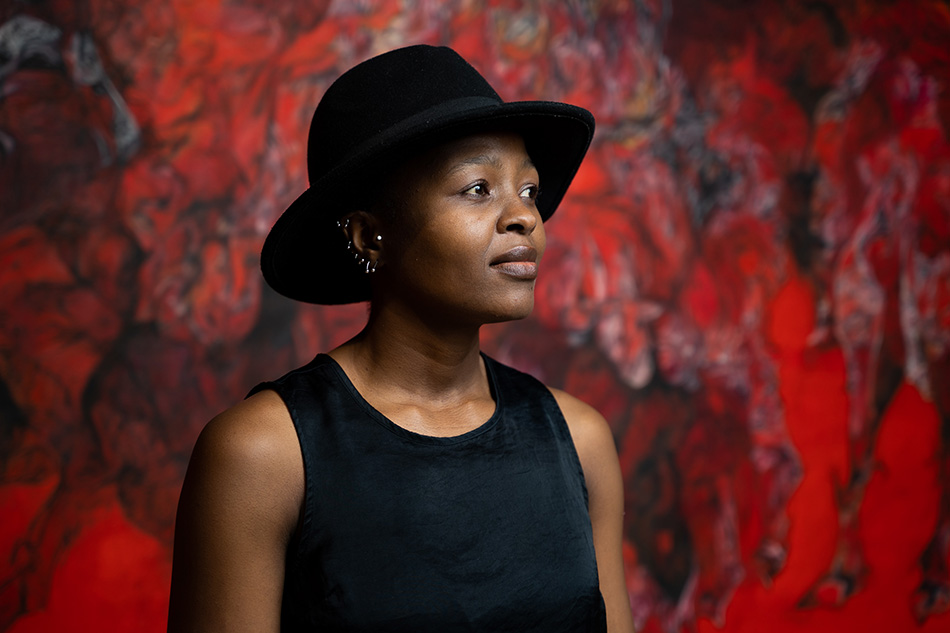Visit and see Philiswa Lila’s exhibiting as part of the Tomorrows/Today section at the Investec Cape Town Art Fair (ICTAF)
The Melrose Gallery is pleased to present a solo exhibition by Philiswa Lila titled ‘Nogolide: Sentimental Value’ in the Tomorrows/ Today section at the Investec Cape Town Art Fair. She is a visual artist, curator and scholar fascinated by the socially relevant and timely issues of authorship and agency. She is interested in memory histories and theories of personal identities. Lila works across disciplines like painting, installation, and performance art, and includes the use of mediums such as animal skin (sheep, goat and cow), beading, wood, paper, photography, video and poetry.
The Tomorrows/ Today Section at ICTAF is to be curated by Nkule Mabaso (Curator at Michaelis Galleries, Cape Town) and Luigi Fassi (Artistic Director of MAN Contemporary Art Museum in Nuoro, Italy).

Philiswa Lila. Courtesy of The Melrose Gallery.
You say that your work navigates the role of memory in family photo albums. How did you come to this approach in your work and was there a specific image or album that inspired this approach?
Philiswa Lila: I use my old family photo album as an intimate object and visual material that performs memory. In 2018 I discovered this old-fashioned family album at home in a storage box. The album did not have photographs and was not in good condition. When I held the album, it brought back a lot of childhood memories. I remembered how photographs used to be organised inside and the intimate moments I spent with family and friends looking and telling stories from the photos. As an object, the album becomes an experience of imagination, emotion, senses, and recollecting.
You are interested in memory, history and personal identity and use storytelling methods to convey certain emotional feelings. Can you explain this approach to us?
What I am mainly trying to convey has to do a lot with storytelling. Daily interactions with objects leave memories in our minds and bodies. These are human traces that become a key guide in narratives we share about who we are and where we come from. I am interested in the stories that linger as mnemonic clues that trigger methods of remembering and also inquiring into how dialogues about remembered experiences are derived from the everyday.
In ‘Nogolide: Sentimental Value’, curated by Nkule Mabaso (Curator at Michaelis Galleries, Cape Town) and Luigi Fassi (Artistic Director of MAN Contemporary Art Museum in Nuoro, Italy), you use your visual material from your family photo album to aid the performance of memories in the present. Why, for you, is this so important?
The themes I used for this exhibition are based on a family photo album, sentimental value, memory, reminiscence, cherished objects, and letters. In the title of the exhibition ‘Nogolide: Sentimental Value’ I am referring to my family photo album as a sentimental object (or cherished object) that is filled with personal experiences and memories.
On the surface of the exhibition is the photo album, but a more in-depth focus is on the memories I have of old photographs that have significant meanings. For example, confronting the way I was looking at myself, or grappling with photos of myself as a young girl that I did not particularly like – and still don’t – based on past feelings I’ve associated with the images. This was important to explore because I was interested in isiteketiso (nickname).
At first, I wanted to write/speak to Nogolide about her dark skin tone. Nogolide was my neighbour in Mthatha, Eastern Cape. She was older than me. When we were young she had a lot of confidence and was very confrontational with older people when she did not like something. I wanted to speak to her about how/what she now thinks of that young girl. To ask her about her name and how she associates it with her personal character. I have this one memory of Nogolide asking me to enter a beauty contest. I refused because I thought she was making fun of me, yet she used to organise and enter beauty contests herself.
You use painting, beading, performance and other artforms to creatively reflect your practice. Can you explain how these different types of practice come together in your work?
The choice of material is connected to an idea that I have at that moment. I think by being able to explore and experiment with different materials I get to understand that process is not based on one particular outcome or one way of viewing art. For example, I can be working on a beaded artwork in the morning and a painting in the afternoon, which means there is a connection already created between the two artworks. there are exhibitions where I will use everyday objects to create an installation piece or use the objects to speak on the idea I have at that particular time.
You are a visual artist, curator and scholar fascinated by the socially relevant and timely issues of authorship and agency. How is your work informed by your curating and scholarly commitments?
My artworks, curating and research are not separate, or I am not trying to create a separation between them. I don’t treat the previous mentioned as individual positions either. When I am curating for an exhibition, I am creating an artwork, and I treat research the same way. They all speak to each other because I am then able to consider things like exhibition space and the environments where my work is shown, including creative practice writing and publishing, which is something I am interested in developing.
Investec Cape Town Art Fair will be open to the public from the 18th of February until the 20th of February 2022. For more information, please visit The Melrose Gallery.



